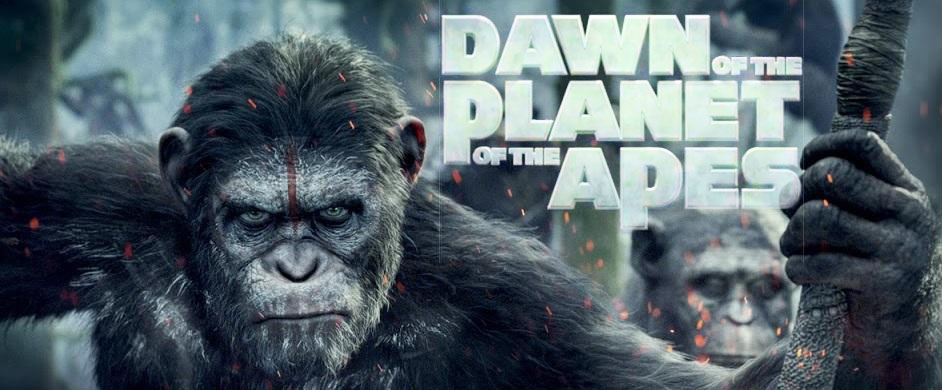What We’re Watching: Dawn of the Planet of the Apes

2011’s Rise of the Planet of the Apes signaled the reboot of the original Planet of the Apes series. The bar was set high, as Rise of the Planet of the Apes was a success in regards to box office profit and critical reception; however, Dawn of the Planet of the Apes, 2014’s sequel, far surpassed it’s earlier counterpart in virtually every aspect.
Plot
Andy Serkis, who reprises his role as Caesar, is now front and center as opposed to his more supporting role in 2011’s Rise. Caesar leads a small group of apes who have developed intelligence and language, which granted them their freedom at the culmination of the previous movie. However, the Apes’ gain is the Humans’ loss. A decade has passed since 2011’s installment, and as predicted in the prior film’s post-credits scene the Simian Flu—the same disease that allowed Caesar and co. to rise—has all but decimated human civilization. The humans are trying to pick up the pieces by strengthening their infrastructure—specifically, they’re seeking to reactivate a nearby dam as a means of generating electricity. Unfortunately, in the decade since the fall of Humanity the dam has become home to Caesar and his group.
Right from the humans’ first contact with Caesar’s group it is apparent that conflict is inevitable. The plot is a simple one—humans are attempting to rebuild their world, whereas the apes’ society is on the rise. The plot is a simple one, and walking into the theater most viewers should have a pretty good idea of what to expect. However, the plot’s simplicity only emphasizes the film’s emotional depth and other stellar elements. In the case of Dawn of the Planet of the Apes less is more.
Character & Cast
What is immediately apparent in Dawn is that Serkis’ Caesar—who absolutely steals the show—is much wiser than in the previous movie. After the Apes realize that some humans have survived the Simian Flu, most view humanity’s remnants as a threat to their burgeoning society. However, Caesar has no qualms with the humans, who he views as desperate after their fall from grace, and is willing to cooperate with them in order maintain the fragile peace. Unfortunately for both parties, Toby Kebbell’s Koba—a chimpanzee who harbors a grudge towards humanity for the multitude of experiments they performed on him in the initial movie—is eager to take matters into his own hands in order to incite a full-blown war between the two groups.
The two apes’ disagreement on how to handle human-ape relations is paralleled by Gary Oldman’s Dreyfus and Jason Clarke’s Malcolm. Dreyfus, similar to Koba, doesn’t believe that Humans and Apes can coexist, whereas Malcolm strives to maintain the peace initially brokered by Caesar. Both actors play their roles very well; however, the one gripe I had with Dawn was that Oldman, who is extremely talented, was somewhat underutilized.
The supporting casts of both the human and ape groups play their roles well. It becomes obvious that both groups are divided within themselves on their opinion on how human-ape relations should be handled. Specifically, the internal conflict within the ape group provides for some of the film’s best moments. Going off of that: the decision to bring back Maurice and Rocket, Caesar’s friends and trusted advisors, from the first movie was a good one. The characters, along with newly introduced apes, add the overall continuity of Caesar’s story—one that can undoubtedly reach the heights of the series’ initial installments.
Visuals & CGI
Often Hollywood’s blockbuster films rely heavily on CGI and special effects. Fortunately, Dawn manages to tone it down. The apes, which are obviously going to be done with CGI, are beautifully done. The actors also make use of the motion-capture system extremely well. Often there are subtle occurrences onscreen (facial expressions, body language, etc.) that provide an authentic feel. Additionally, the action sequences throughout the film are never over-the-top. As I said earlier, with Dawn of the planet of the Apes less is more.
Final Verdict
Dawn of the Planet of the Apes improves on its 2011 predecessor in every aspect. Despite the fact that the film is a relatively simple one, Dawn is wildly entertaining and beautifully done. Thankfully, the ending of the film doesn’t conclude Caesar’s tale—there is a third film already in the works. The franchise’s bar has been raised, again.
Jack Haanraadts is currently an undergraduate student at SUNY New Paltz. He thoroughly enjoys reading and writing, philosophical debates, soccer, and a quality cup of coffee. Follow him on Twitter:

















